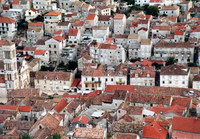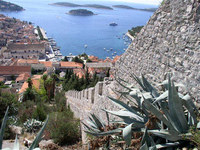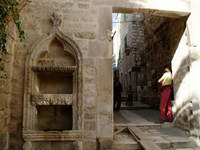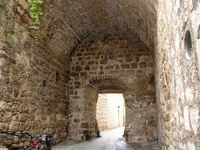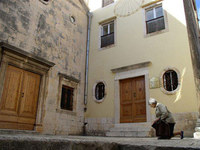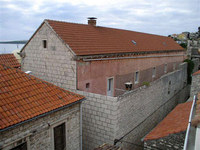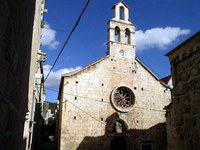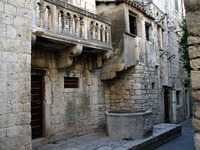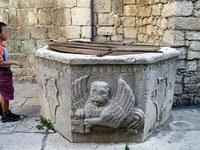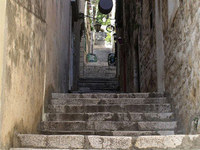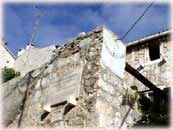Groda
The oldest existing part of City of Hvar is placed inside city walls bellow main city fortress "Fortica", and is called "Groda" meaning downtown. It occupies north and northeastern part of ancient city center.
Traces of life take us to the time of Illyrians, but written by documents we may conclude the following.
City of Hvar was founded after 1278. A.D. when Venetians, conquering the island for the second time, remove the municipality and bishop's diocese from Old Hvar (today Stari Grad meaning Old City) to the place until that time called Lesna or Lisna (later Novi Grad - New City or Novi Hvar - New Hvar, today City of Hvar).
Removal took place because of harbor's significant traffic position. At the same place was fortified town at the time of late antics (4th - 7th century A.D.) but because of micro strategic reasons at the opposite site - at the northern side of hill Burka (Sv. Nikole - St. Nicholas or Glavice - Heads) south of present square - Pjaca.
Groda was sowly building, and it was belted with city walls at the time of the third Venetian government at the middle of 15th century. By the contract concluded between people of Hvar and Venetians at 1420 old Commune had right to keep possession of most of its income but it was obliged to build, maintain and repair all public buildings. Often forgotten, all those monuments, even the city walls were built at the expense of people of Hvar.
To Groda and from it take four gates, one at east and west and two at south (southwest and southeast.).
Southwestern gate was considered the main (Porta Maistra) because it takes from Pjaca to the very heart of Groda and further to the fortress Fortica. Beside this name, at 15th century also appears name Gate of the Palm-tree (Porta dell Datallo) because very big palm - tree grew at the vicinity. That palm - tree was also painted at the city vedute from that time.
Southeastern gate was called St. Mary's or Bishop's after cathedral and bishop's court nearby.
Western gate is Gate of Goljava (or present Gojava) and it takes to the part of City having the same name.
Eastern Gate is Gate Badoer as they were called in past after some forgotten Venetian official. People of Hvar call them Grodno vrota meaning City Gate because other gates connect different parts of City while this one is the only gate taking out of the City.
At most of these gates were heralds of Venetian officials who put them there not by their merit but as the symbol of personal power. Those symbols of vanity were removed by the orders of Venetian central government at 17th century.
It is worth mentioning some sacral buildings. Church of Saint Kuzma and Damjan at southwestern part of Groda standing beside Leroj (City Clock), grow out of Romanic housing (currently restoring) at 15th century. The Fraternity Of the Holly Spirit built Church of the Holly Spirit in the second half of 15th century (consecrated at 1493) at the place of an older and smaller church dated at 14th century. This proud church placed at the Pjaceta (Little Square) by the eastern city gate still keeps old fraternity tradition. System of convents dedicated to Saint John the Baptist and Saint Anthony the Abbot is very interesting. By the year 1663 it is a home of Hvar`s Benedictine nuns. The core of the convent is suited at the house (still partly preserved) of the great Croatian and Hvar poet Hanibal Lucic (1485 - 1553), which his bride Julija dedicated to this sacred cause. Convent consists of the baroque church from 17th century and the museum worth visiting.
Groda has many interesting old houses mostly built in period from 14th to 17th century. Some of the most representative ones were built during 15th century by the southern city wall, just above Pjaca. Beside church of Saint Kuzma stands House of Jaksic, and by its side maybe the prettiest House of Uzizic (miscalled Hektorovic).
Its building started at 1463 in late Gothic style but building and renovation took to present time, almost five and a half centuries later, which could be a world record. To the north is the birth house of famous polyglot and natural scientist Mate Botteri (1808 - 1877); today Konoba (Tavern) Leporini is placed there.
More to the east at the city walls is Gothic - Renaissance style House of Paladinic (present restaurant Paladini), and by its side smaller one which belonged to the famous writer Petar Hektorovic (present restaurant Zlatna Školjka - Golden Shell). Further, above southeastern city gate is Palazzo Piretic-Jaksa, recently renovated. At the east end of southern wall is House of Misetic resembling a watch - tower (restaurant Paradies Garten).
At the street by the southern city wall is the system of Houses of Gazarovic built during 14th and 16th century, probably belonged to the poet Marin (1575 - 1638), (present restaurant Lucullus). Further to the northeast is old City Well, which was built at 1475 and has a symbol of Venetian lion holding a closed book, meaning the state was in war in that time. By the well is a probable birth house of Petar Hektorovic, currently restoring.
At the crossing of street leading from southwestern city gate to Fortica and street between eastern and western city gate stands House of Lupi, which has been built between 15th and 17th century (tavern Novak - Kranjac). Northern, by the same stairway towards Fortica is the humble but important house, keeping the memory of well-known man from Hvar. Niko Karkovic (1838 - 1918) was born there. He was the man who, during the famous naval battle by the island of Vis at 20th July 1866, has captured the Italian flag from battleship Palestro, and was decorated for his courage by Austrian emperor and Croatian king Franz Josef. By the hundredth anniversary of that battle in 1966 the memorial tablet was placed on that house.
Battle of Vis, fought mostly by Croatian sailors at the Austrian side, has great importance for Croatian national history, especially for Dalmatia, because victory over Italians ensured that this province would not be in Italian hands for the next fifty years. At Karkovic's house Tavern Menego is placed now (owned by Dinko Kovacevic) and tourists going to Fortica or coming back from it can't miss it.
Visiting the oldest and main city fortress is obligatory for all guests of Hvar. It was built at 14th, renovated at 16th century. At the 19th century an annex was built on it. At the very spot where it is placed was a fortress even in ancient history. The sight from that fortress is unforgettable.
There are many stories written about places worth seeing, values and history of city and island of Hvar, whose every little part is the story for itself. We are going to try conjuring up in fancy and describing part of City of Hvar where we live and work.

